




Key Takeaways
- Track ACT progress consistently to boost scores and reduce tutoring admin time.
- Identify learning gaps early and tailor study plans using performance data.
- Use tools like EdisonOS for automated reports, analytics, and faster interventions.
Learning how to track ACT prep progress effectively transforms both student outcomes and your tutoring business. With 10, 20, or even 50+ students at different skill levels, relying on spreadsheets and manual records creates bottlenecks that limit growth and lead to frustrated parents asking for progress updates you can't easily provide.
A systematic approach to ACT student progress tracking helps tutors quickly identify which students are improving and which need immediate intervention. More importantly, it builds the credibility parents expect while reducing the administrative tasks that cause tutor burnout.
When data drives your ACT prep decisions, students see measurable growth that boosts their confidence and motivation. In this article, you will discover a repeatable framework, whether manual or tool-assisted, to assess, review, and act on student performance that scales with your tutoring practice.
Why monitoring ACT progress is important for success
Without systematic ACT prep analytics, even experienced tutors struggle to pinpoint why students plateau or regress. Regular progress monitoring transforms guesswork into targeted intervention, ensuring every study session drives measurable improvement.
Effective ACT tutoring metrics provide the foundation for scaling your practice while maintaining quality outcomes.
Here's why consistent progress tracking is non-negotiable:
- Identifies precise learning gaps: Rather than assuming weaknesses, data reveals exactly which question types, timing issues, or content areas need attention. A student scoring 18 in Math might excel at algebra but struggle with geometry—information that reshapes your entire teaching approach.
- Enables proactive intervention: Instead of discovering problems during final practice tests, ongoing tracking lets you address issues immediately. When you notice reading comprehension scores dropping over three sessions, you can pivot strategies before frustration sets in.
- Builds parent confidence and trust: Concrete progress reports showing improvement from 22 to 26 composite scores create powerful testimonials. Parents see their investment working and become your strongest referral sources.
- Optimizes study time allocation: Performance data shows which sections deserve more attention and which are ready for maintenance mode. This precision prevents over-drilling strong areas while neglecting improvement opportunities.
- Maintains student motivation: Visible progress combats the ACT prep burnout that derails many students. Celebrating incremental wins keeps momentum high during challenging preparation periods.
Tools and resources for tracking ACT progress
Tracking ACT prep progress is easiest when you combine official, free tools with a purpose‑built tutoring platform. Below is a curated list, organized from general to all‑in‑one solutions:
1. EdisonOS - An ACT test prep platform with built‑in ACT analytics and test delivery
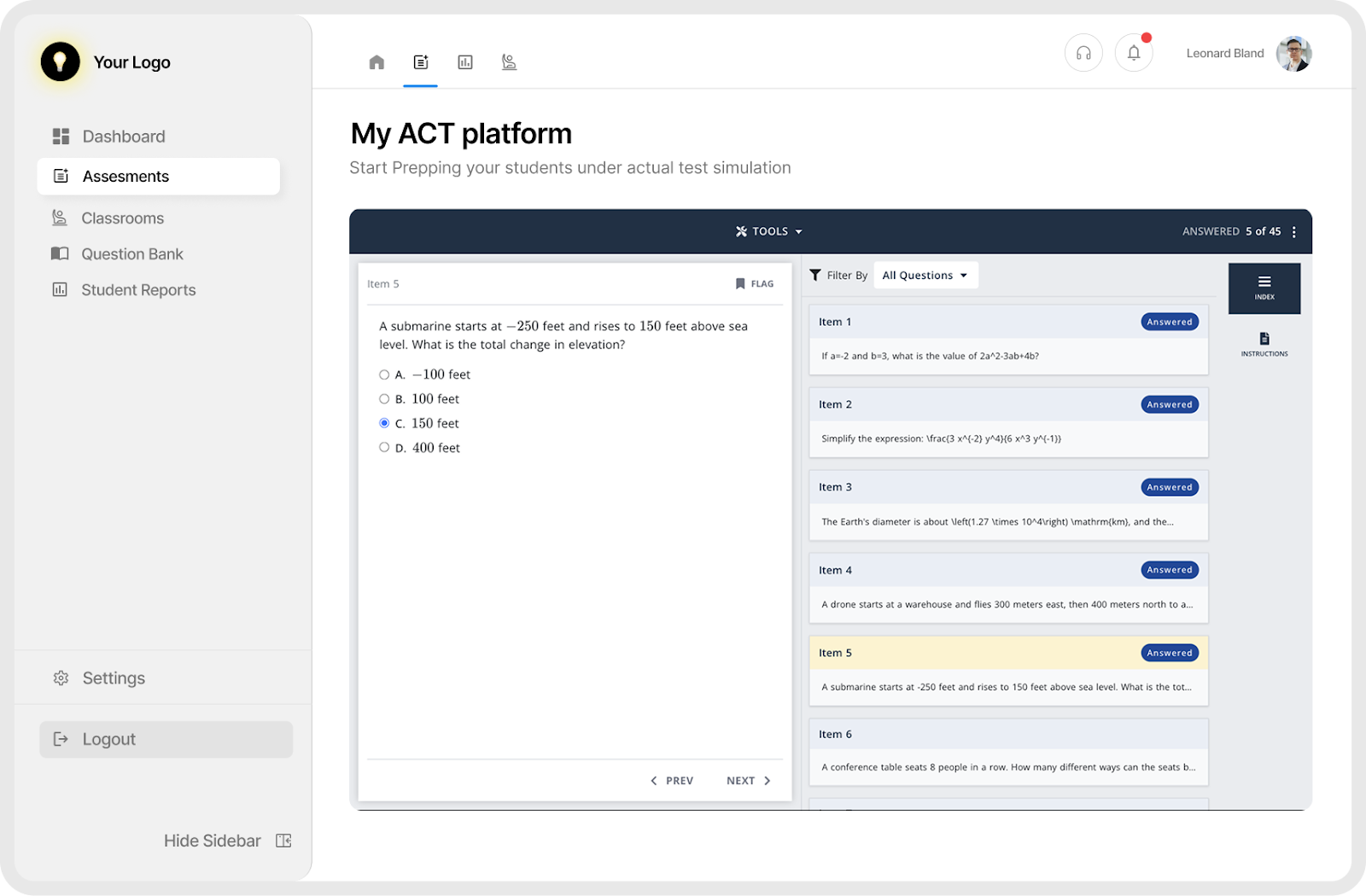
EdisonOS’ ACT test prep dashboard
- Build Your Own Test (BYOT): Drag questions from a 5,000‑item library or upload your own via Excel in minutes—ideal for weekly mocks and large centers.
- Real‑test simulation: On‑screen calculator, flagging, timer, navigation bar and instructions tab mirror the digital ACT interface exactly.
- Offline + OMR mode: Generate printable PDFs and bubble sheets, then auto‑grade scanned responses to merge paper‑based and online data seamlessly.
- Live sessions & study plans: Host Zoom‑style classes in‑platform, assign varied question formats (drag‑and‑drop, fill‑in‑the‑blanks), and monitor homework completion.
- Granular reporting: View scaled scores, question‑level analytics, time‑per‑item heatmaps, session logs, parental reports, and detailed summaries—filterable by student, cohort, or branch
2. ACT Online Prep (Official) - Free official practice with basic progress reports
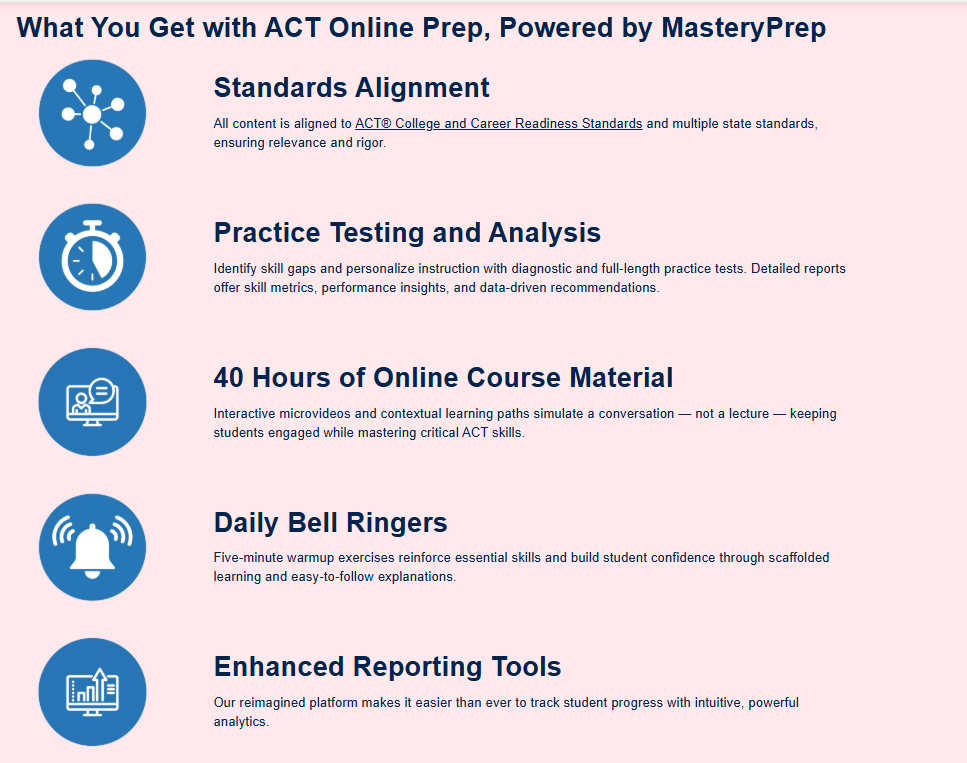
- Full‑length practice tests and sectional quizzes
- Personalized study plans based on initial diagnostics
- Basic analytics: composite and section scores, suggested review topics
3. Magoosh ACT Prep - Video lessons + adaptive practice with smart tracking
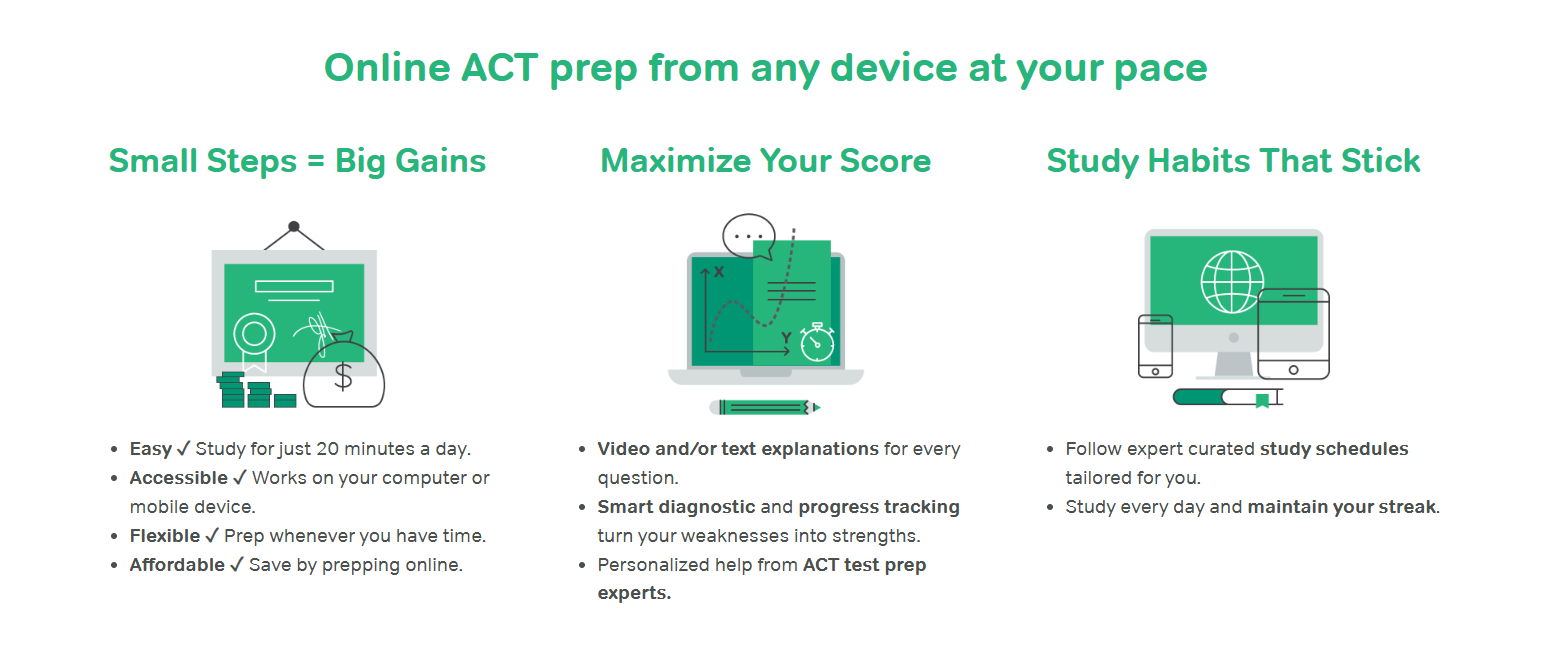
- Thousands of practice questions with detailed explanations
- Tracks accuracy, pacing, and topic‑wise performance
- Score projections and progress dashboards
4. UWorld ACT Question Bank - High‑fidelity questions + detailed analytics
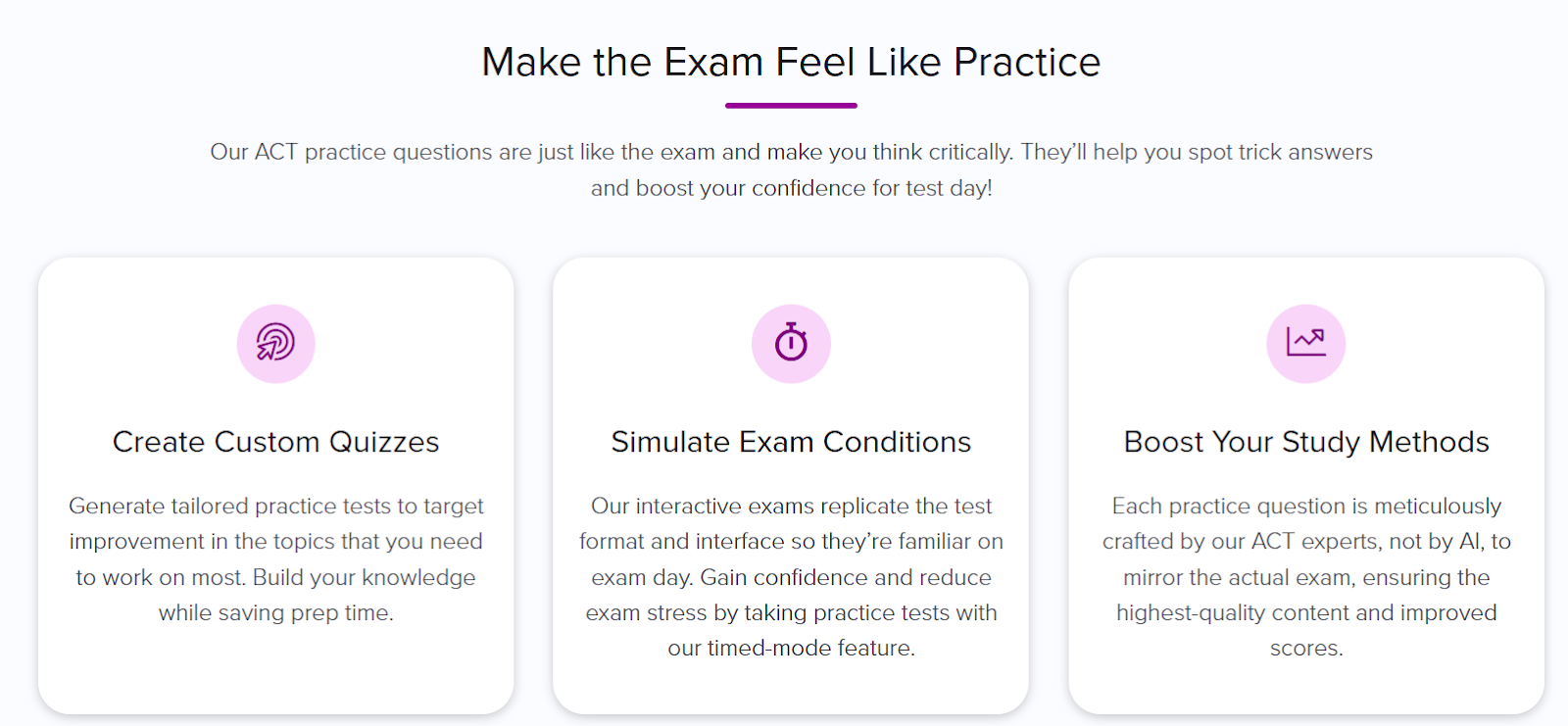
- Exam‑style questions mirroring ACT difficulty
- Time‑per‑question metrics and subskill breakdowns
- Ability to assign targeted question sets based on performance
5. DIY Google Sheets / Excel Trackers - Fully customizable manual tracking
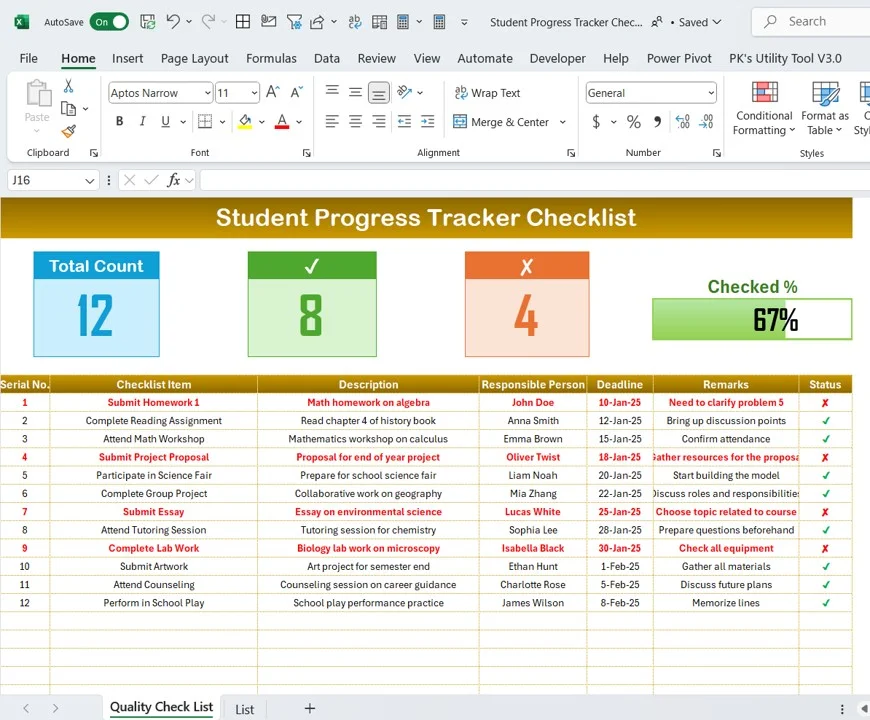
- Log practice test dates, section scores, timing data, and error types
- Use formulas and conditional formatting to highlight trends
- Ideal for tutors with small cohorts or unique metrics
By using platforms like EdisonOS to streamline the tracking process, tutors can gain both the precision of detailed analytics and the flexibility of custom test creation, streamlining progress tracking and maximizing ACT score improvements. If you have fewer students and operate at a small scale, you can utilize free options as well, like the official ACT prep by MasteryPrep.
Key metrics to track for ACT progress
Successful ACT prep improvement relies on tracking the right data points consistently. Rather than drowning in numbers, focus on these seven essential metrics that directly impact scores and reveal actionable insights:
1. Practice test composite scores
- What to track: Overall scaled score (0–36) each time
- Example: Student A scores 21 on Test 1 and 25 on Test 2
- Why it matters: A steady rise shows real improvement and can be shared with parents
2. Section scores
- What to track: English, Math, Reading, Science separately
- Example: English 30, Math 28, Reading 24, Science 24
- Why it matters: Pinpoints where to spend extra tutoring time (e.g., boost Reading drills)
3. Timing/pacing data
- What to track: Questions completed vs. time left per section
- Example: Finished Reading with 2 minutes to spare vs. last time ran out of time
- Why it matters: Helps fine‑tune pacing drills so students avoid rushed mistakes
4. Accuracy rate
- What to track: % correct in each section or question type
- Example: Math accuracy 80%, Reading accuracy 60%
- Why it matters: Highlights content gaps—if punctuation errors dominate, schedule grammar mini‑quizzes
5. Error patterns
- What to track: Why questions were wrong: careless, concept gap, misread
- Example: 5 careless errors, 8 geometry gaps, 2 misreads in one test
- Why it matters: Targeted fixes—if geometry is weak, assign 10 geometry questions in 20 minutes
6. Question‑type weaknesses
- What to track: Performance by sub‑skill (e.g., trigonometry, inference)
- Example: Student misses 70% of trigonometry questions but nails algebra
- Why it matters: Assign extra trigonometry practice sets until accuracy hits 80%
7. Trend vs. goal
- What to track: Distance from target score over time
- Example: Goal = 30, current = 26, gap = 4 → now gap = 2 after two tests
- Why it matters: Keeps students motivated and shows how close they are to their goal
Implementation tip
For tutors managing 5-10 students, a well-organized spreadsheet can handle this tracking effectively. Focus on the top 4 metrics: composite scores, section scores, timing data, and error patterns.
Tutors with larger practices benefit from dedicated platforms like EdisonOS that automatically capture and analyze these metrics, generating progress reports that build parent confidence while saving hours of manual data entry.
The key is consistency—track the same metrics for every practice test and use the insights to adjust study plans immediately, not weeks later.
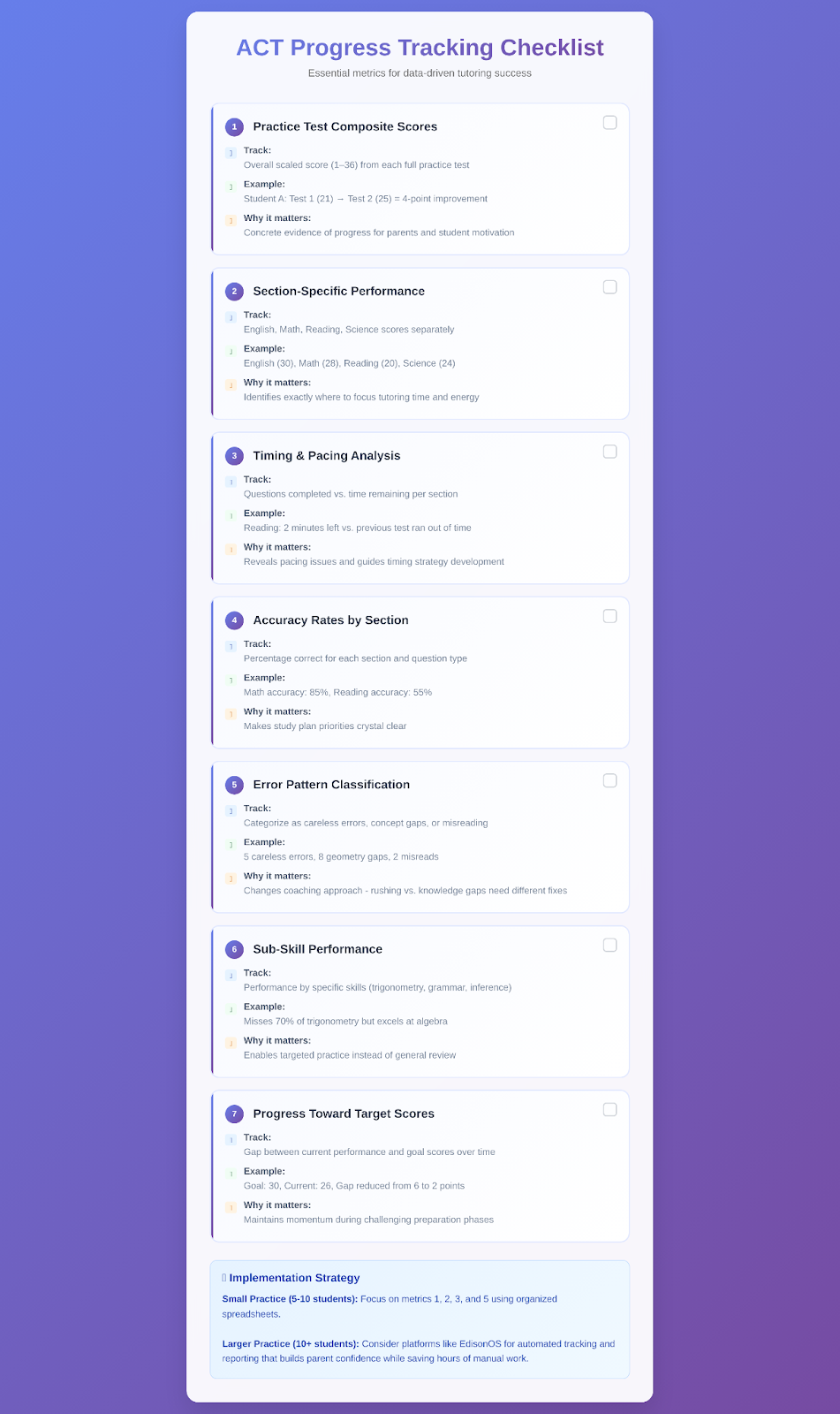
Strategies to monitor and improve ACT performance
Effective ACT prep improvement requires a systematic approach that combines consistent assessment with targeted intervention. These proven strategies help tutors scale their impact while maintaining personalized attention for each student.
Assessment and data collection strategies
1.Schedule regular full-length practice tests
Establish a baseline with a diagnostic exam, then schedule practice tests every 2-3 weeks under authentic test conditions. This rhythm provides enough data points to track trends without overwhelming students. After each test, conduct a thorough review session focusing on error patterns and strategic adjustments. EdisonOS offers free ACT practice tests that mirror the actual exam format and difficulty.
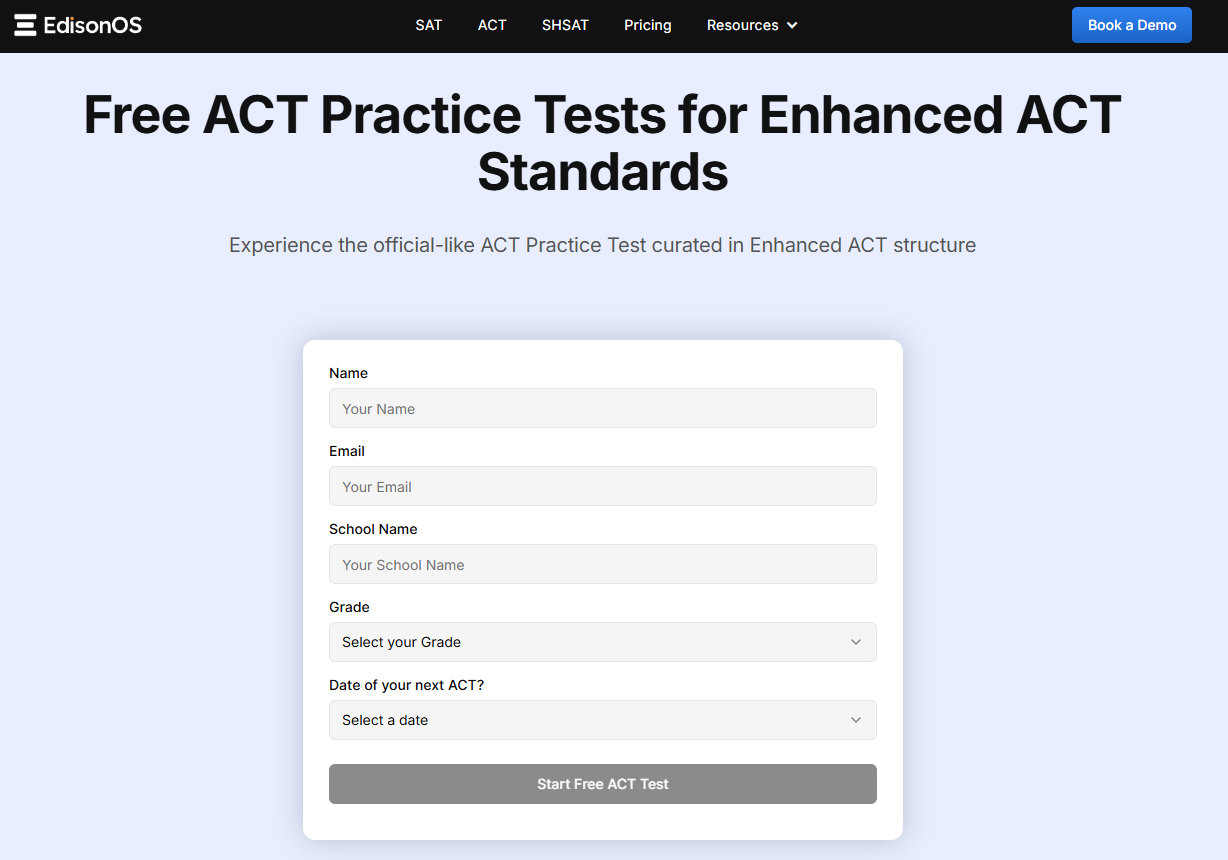
2.Conduct deep-dive score analysis
Move beyond composite scores to examine section and sub-skill performance in detail. Break down results by content area—Algebra versus Geometry in Math, or inference versus main idea questions in Reading.
Share specific findings with students and parents: “Your English jumped from 20 to 25, but Science stayed at 23. Let's target data interpretation next.”
3. Leverage advanced digital analytics
Use modern platforms like EdisonOS to track question‑by‑question results, time‑per‑question data, and predictive scoring, using the ACT scoring chart. These instant dashboards reveal performance patterns that would take hours to identify manually, enabling targeted practice assignments without the administrative burden.
.gif)
4. Master pacing through strategic timing drills
Document completion rates versus allotted time for each section, then teach specific benchmarks: approximately 30 seconds per English question, 60 seconds per Math problem. Run focused timed drills until students consistently finish with 2-3 minutes remaining for review.
5. Keep an error log or study journal
Guide students in keeping detailed error logs that categorize each mistake by topic, error type (careless versus conceptual), time investment, and correction strategy. Weekly journal reviews transform random mistakes into systematic improvement opportunities, such as discovering a pattern of misreading Science graphs that requires visual processing practice.
6. Incorporate peer or group feedback
Organize small study groups where students explain difficult problems to peers and quiz each other on frequently missed question types. This peer teaching approach reinforces learning while providing tutors with additional insight into student understanding and progress patterns.
7. Set SMART goals and milestones
Define specific score targets (e.g., Increase Math score from 25 to 28 in six weeks) and break them into checkpoints. Track actual vs. target scores over time; celebrate milestone wins and adjust tactics if a goal isn’t met.
Integration for maximum impact
The most successful tutors combine multiple strategies systematically. Start with regular testing and deep analysis, then use the insights to guide targeted interventions through pacing work, error analysis, and collaborative learning.
Digital platforms streamline this process, but the key is consistency in implementation and responsiveness to the data you collect.
Remember: ACT tutoring metrics improve most when students see the connection between their effort and measurable progress. Make the data visible and actionable, not just collected.
Streamline ACT Progress Tracking and Boost Scores with EdisonOS
While the manual strategies above work effectively for smaller tutoring practices, scaling beyond 10-15 students often creates an administrative bottleneck that limits growth and teaching quality. This is where a comprehensive ACT dashboard transforms both efficiency and outcomes.
From spreadsheets to smart analytics
EdisonOS eliminates the hours spent manually tracking ACT student progress across multiple spreadsheets. Every data point—time per question, section accuracy, completion rates, and error patterns—appears on a unified dashboard that updates automatically after each practice test. Instead of spending Sunday afternoons calculating percentages and creating reports, you instantly see where each student excels or needs intervention.
Advanced analytics that scale your expertise
The platform's analytics engine identifies performance patterns you might miss in manual tracking. When a student's Reading comprehension drops 15% over three tests while Math improves steadily, EdisonOS's detailed analytics make these patterns immediately visible, enabling you to quickly identify areas needing targeted intervention.
Set specific goals—like raising a student from 25 to 30 composite—and watch the system map progress milestones and provide data-driven study recommendations.
Automated reporting that builds parent confidence
Remember those parent requests for progress updates that used to require hours of report preparation? EdisonOS generates professional performance reports automatically, complete with score charts, improvement graphs, and next-step recommendations. These detailed reports keep students and parents informed of progress, creating transparency that builds trust and reduces the "Is tutoring working?" conversations.
In short, EdisonOS consolidates ACT prep content, tracking, and reporting into one platform—saving you hours of admin work and helping your students improve faster.
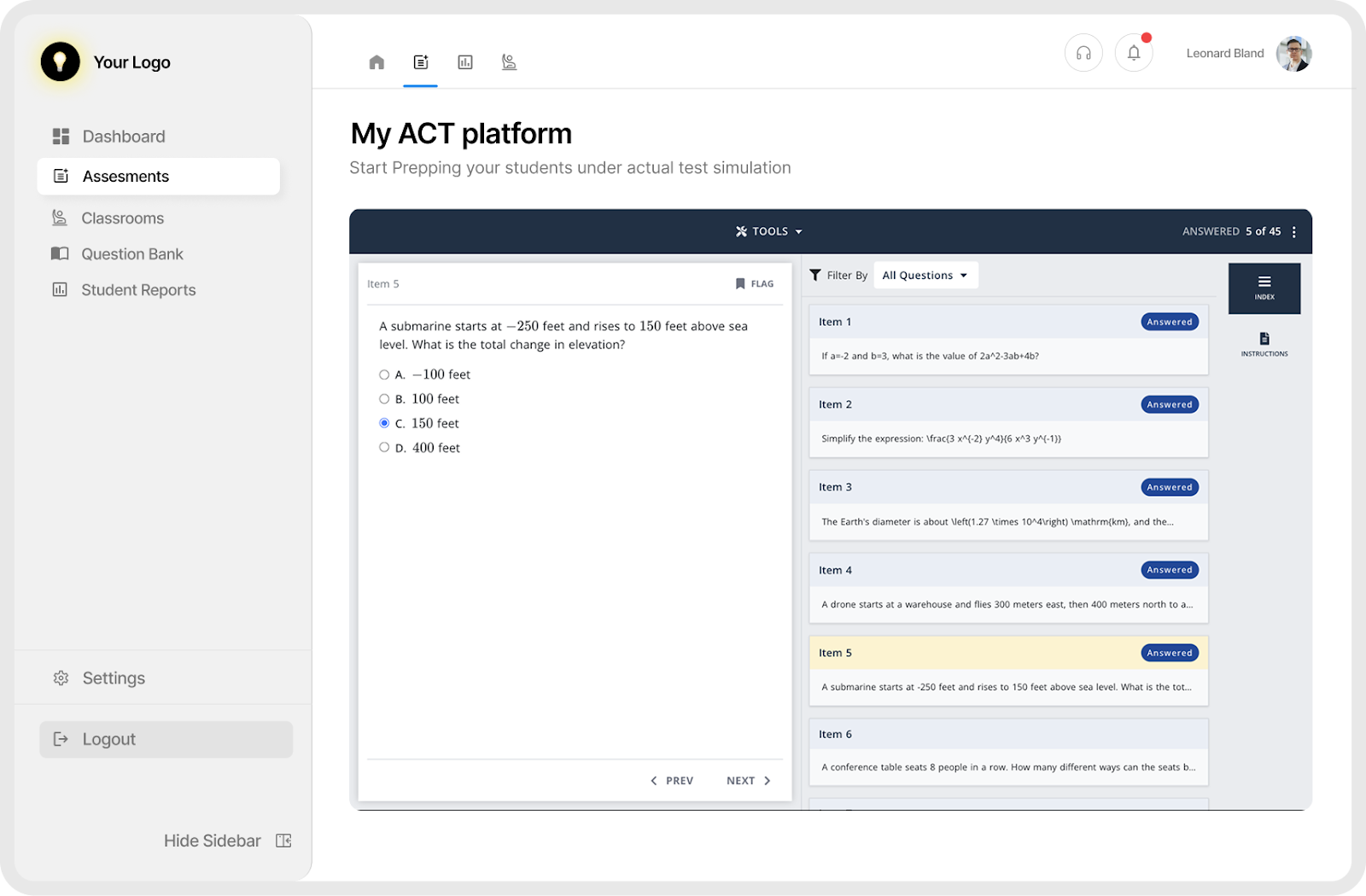
The bottom line: More teaching, less admin
By consolidating ACT prep analytics, content delivery, and progress reporting into one platform, EdisonOS significantly reduces administrative workload. That time returns to what you do best—teaching and coaching students toward their target scores. The platform features expert-vetted ACT questions and provides detailed breakdowns of student performance where every second spent is analyzed.
The platform also offers free Enhanced ACT Mock Tests and integrates seamlessly with the manual tracking strategies outlined above, so you can start small and scale your approach as your practice grows.
Book a demo with EdisonOS to explore how it can make students’ ACT prep tracking an easy feat for you!
Frequently asked questions
Aim for a baseline diagnostic, then schedule one full-length mock every 2–3 weeks. This cadence balances actionable data with sufficient time for targeted practice between tests.
While composite scores matter, section-wise subscores (English, Math, Reading, Science) reveal specific strengths and weaknesses. Tracking these lets you pinpoint where to focus tutoring efforts.
Have students note the time remaining at regular checkpoints (e.g., every 10 questions in Math or after each Reading passage). Logging these times in a simple spreadsheet shows pacing trends and highlights sections needing pacing drills.
Encourage students to keep an “error log” after each practice session, noting question type, mistake reason (content gap vs. carelessness), and time spent. Reviewing this log weekly uncovers patterns you can address directly.
Share concise, visual reports (e.g., graphs of score trends or pacing improvements) after every two or three practice tests. Clear, data-driven updates build trust and help parents support study routines at home.
EdisonOS centralizes assessment creation, timing data, section analytics, and progress dashboards in one platform. Tutors assign tests, auto‑grade OMR or digital exams, and instantly view per‑student heat‑maps and reports—eliminating manual logs and saving hours each week.
Tutors Edge by EdisonOS
in our newsletter, curated to help tutors stay ahead!
Tutors Edge by EdisonOS
Get Exclusive test insights and updates in our newsletter, curated to help tutors stay ahead!
Recommended Reads
Recommended Podcasts






.png)




.png)
.webp)
